by Elizabeth Shultz
Nestled between the peak heat of July and the crispness of October’s flaming foliage is that special span of outdoor living in Pennsylvania that is the perfect time to hoist your kayaks and canoes onto your shoulders, strap your sturdiest water shoes to your feet, and set out to feast your eyes on some of the architectural and engineering gems that crisscross Pennsylvania’s diverse bodies of water. In the true Commonwealth spirit of discovery, before our rivers turn to frozen slush and our streams start to crunch, let your paddles guide you under some of Pennsylvania’s treasured pieces of transportation history – starting with those listed below!
Logan Mills Covered Bridge, Clinton County
Point your compass towards the center of the state and paddle along Fishing Creek in Logan Township, Clinton County, to bear witness to the Logan Mills Covered Bridge. This jewel has the distinction of being both the only remaining covered bridge in Clinton County as well as the only bridge in Clinton County that is currently listed in the National Register of Historic Places. Built in 1874, this covered bridge utilizes the Queen Post Truss structural system and crosses Fishing Creek at a length of 55 feet. A Queen Post Truss structure results from the modification of a King Post Truss, which is a simple triangular bracing system, in order to easily increase the length of the crossing. If after visiting the Logan Mills Covered Bridge you want to transfer you efforts from paddle-power to peddle-power, two BicyclePA Routes – Route G and Route V – also wind through beautiful Clinton County near the Logan Mills Covered Bridge.
Bridge between Madison and Mahoning Townships, Armstrong County
This 1895 stone and concrete solid spandrel arch bridge spans Mahoning Creek, which feeds into the Allegheny River, and was listed in the National Register of Historic Places for its engineering significance in 1988. The spandrel – the triangular area above either end of an arch – is considered “closed” or “solid” when that space is fully filled in with a structural material. In the case of this bridge, the solid spandrels are stone. While you are in the area and are chest-deep in watery history, take the opportunity to visit the nearby National Register listed Allegheny Lock and Dam No. 9 site to see firsthand the Depression-Era work of the Army Corp. of Engineers!
Cedar Street Bridge, Franklin County
While this bridge in Williamson, Franklin County is closed to automobile and pedestrian traffic, an up-close look at this rare structure via watercraft may be just enough to soften those end-of-summer blues! As one of the oldest metal bridges in Pennsylvania, built in 1876 by T. and S. White of New Brighton, PA, the Cedar Street Bridge is an extremely rare example of a Whipple Through Truss bridge. Whipple Trusses fall into a subcategory of the Pratt Truss, which means that the bracing of the bridge is done through the use of diagonal members in tension. The historical significance of this uncommon feat of engineering is further compounded by the presence of decorative cast iron detailing throughout the bridge. As an added incentive to head to Franklin County, setting out to paddle along Back Creek under the Cedar Street Bridge will pay you back double for your effort – you will also get to gaze upon the late 1800s Pratt Truss Williamson Railroad Bridge that was constructed right next to the Cedar Street Bridge!
Academia Pomeroy Covered Bridge, Juniata County
While you may have to portage your kayaks or canoes through parts of Tuscarora Creek to get to the Academia Pomeroy Covered Bridge, that just means that you will have the opportunity to get up-close-and-personal with this 1902 gem that holds the distinction of being the longest covered bridge in Pennsylvania at 278 feet from opening to opening! Connecting Spruce Hill and Beale Townships, this alluring bridge is the creation of architect James M. Groninger and was listed on the National Register of Historic Places in 1979. This bridge has a Burr Arch Truss structural system – defined as the combination of several King Post Trusses and a long arch to strengthen the structure – which is a distinct feature of covered bridges in this area of Pennsylvania. For example, while Burr Arch Truss covered bridges are the most common in this area of Central Pennsylvania, in Washington and Greene Counties there is only one Burr Arch Truss covered bridge. In the National Register nomination form for the Academia Pomeroy Covered Bridge Susan Zacher and Tobi Casner write that “this may be tied to the practical reason of length, where Burr type trusses are used for spans over 100 feet, or related to the skill of local bridge builders.”[1]
[1] Susan Zacher and Tobi Casner. “Covered Bridges of Juniata and Snyder Counties,” National Register Form (1988), 3.
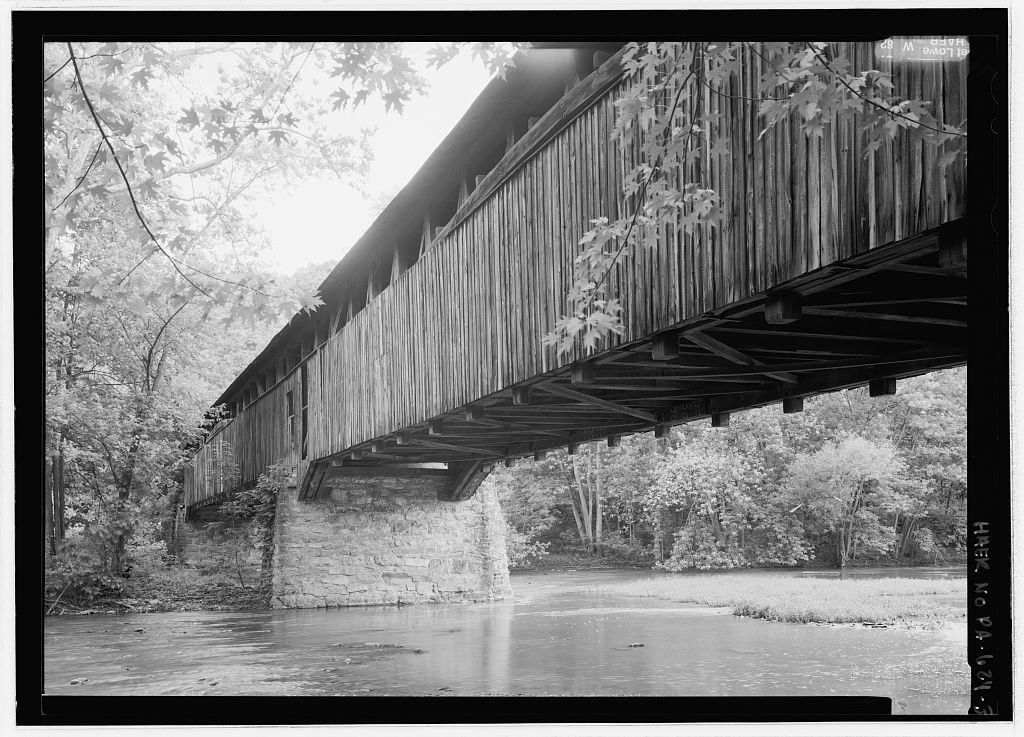
Academia Pomeroy Covered Bridge, 1995. Photo by Historic American Buildings Survey. Courtesy of the Library of Congress.
Hunter Station Bridge, Forest County
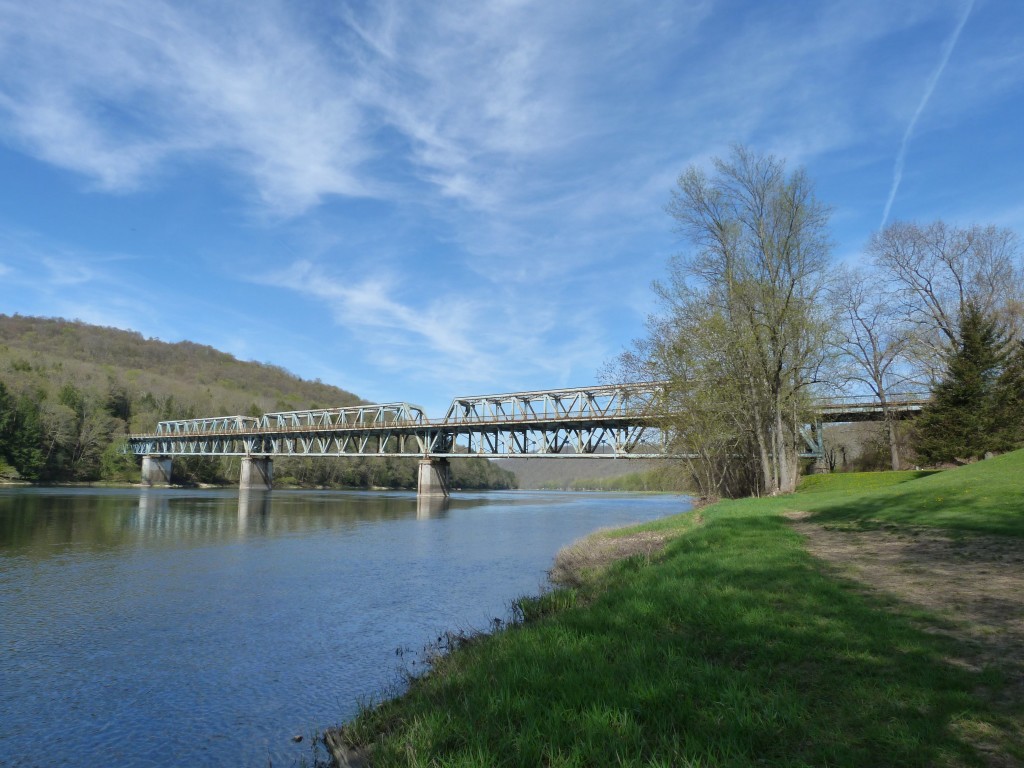
Hunter Station Bridge, taken by Nathaniel Holth. Courtesy of historicbridges.org. 2013. Used by permission of Nathaniel Holth.
You won’t need to worry about portaging your kayaks when you paddle along the Allegheny River in Forest County towards the Hunter Station Bridge! The rare Half Deck Truss/Half Through Truss design that is seen here (meaning that the roadway runs through the middle of the truss structural system, and is not located at either the bottom of the structure, which would be a through truss, or at the top of the structure, which would be a deck truss) was constructed to allow the bridge to remain open during flooding situations. Built in 1934 by the P.I. Cox Construction Company in conjunction with the Pennsylvania State Highway Department (the early iteration of today’s PennDOT), this Half Deck/Half Through Pratt Truss bridge is significant in part due to its adaptation of an established bridge design to better suit the environment.
Keefer Covered Bridge, Montour County
If the mighty Allegheny River mentioned above seems too swift for your casual paddle, the 20 mile long Chillisquaque Creek – over which the Keefer Covered Bridge crosses – is a peaceful alternative! This calm tributary to the West Branch of the Susquehanna River winds its way through four of Pennsylvania’s beautiful rural counties, and, in addition to the Burr Arch Keefer Covered Bridge built in 1853 by William Butler, is also crossed by two of Pennsylvania’s other historic covered bridges. Nearby in Montour County the 1881 Gottlieb Brown Covered Bridge crosses the Chillisquaque Creek in Liberty Township, while further south at the junction of East Chillisquaque Township and West Chillisquaque Township in Northumberland County is the 1830 Rishel Covered Bridge, which is believed to be the oldest covered bridge in the United States! A sunny day’s journey down Chillisquaque Creek – stopping perhaps to visit the nearby National Register listed 1814 octagonal one-room stone school house, Sodom School, in West Chillisquaque – as the potential to satisfy your covered bridge dreams!
Layton Bridge, Fayette County
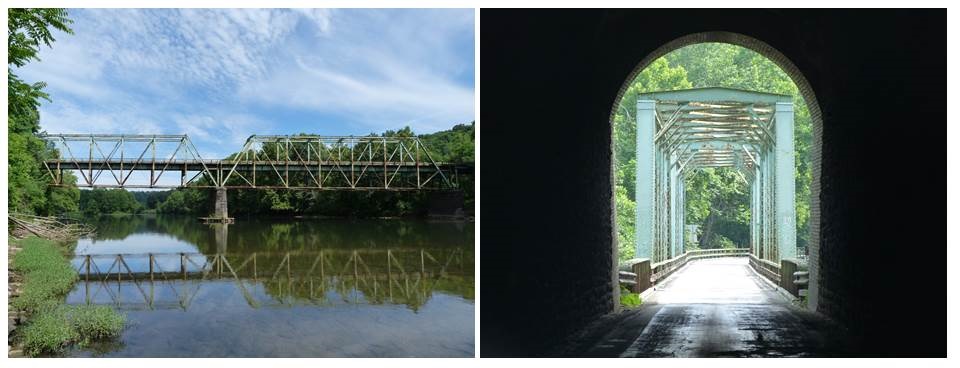
Layton Bridge and Layton Tunnel, taken by Nathaniel Holth. Courtesy of historicbridges.org. 2013. Used by permission of Nathaniel Holth.
This 1899 Pratt Combination Truss bridge carries Layton Road over the Youghiogheny River between Perryopolis and the nearby town of Layton in Fayette County. This National Register listed bridge is one of Pennsylvania’s unique and significant examples due – in part – to the fact that it demonstrates a combination of two truss styles, much like the Hunter Station Bridge in Forest County. Besides its distinctive engineering, the brick and stone tunnel that accompanies the Layton Bridge is a special treat for visitors! The excellent view of this bridge from a canoe is only matched by the vantage point offered by the Great Allegheny Passage Rail Trail that also passes beneath this historic bridge!
English Center Bridge, Lycoming County
Much like Fayette County’s Layton Bridge, the National Register listed English Center Bridge in Lycoming County also features a structural system that is significant because of its uniqueness. Part truss bridge and part suspension bridge, this distinctive crossing spans Little Pine Creek in Pine Township at a length of over 300 feet. Constructed in 1891 by Dean and Westbrook of New York, New York, the English Center Bridge is one of the few suspension bridges in Pennsylvania that was designed for a rural setting that is still open to automobile traffic. If you are feeling especially adventurous while visiting Lycoming County, after visiting the English Center Bridge you are ideally situated to paddle south down Little Pine Creek until you reach Pine Creek itself to visit the National Register listed 1890 Brown Township Bridge – or, if you are feeling ready to get back on dry land for a leisurely stroll, you can head to the nearby National Register listed Millionaire’s Row Historic District in Williamsport to experience a vastly different landscape.
Kiefel Bridge, Somerset County
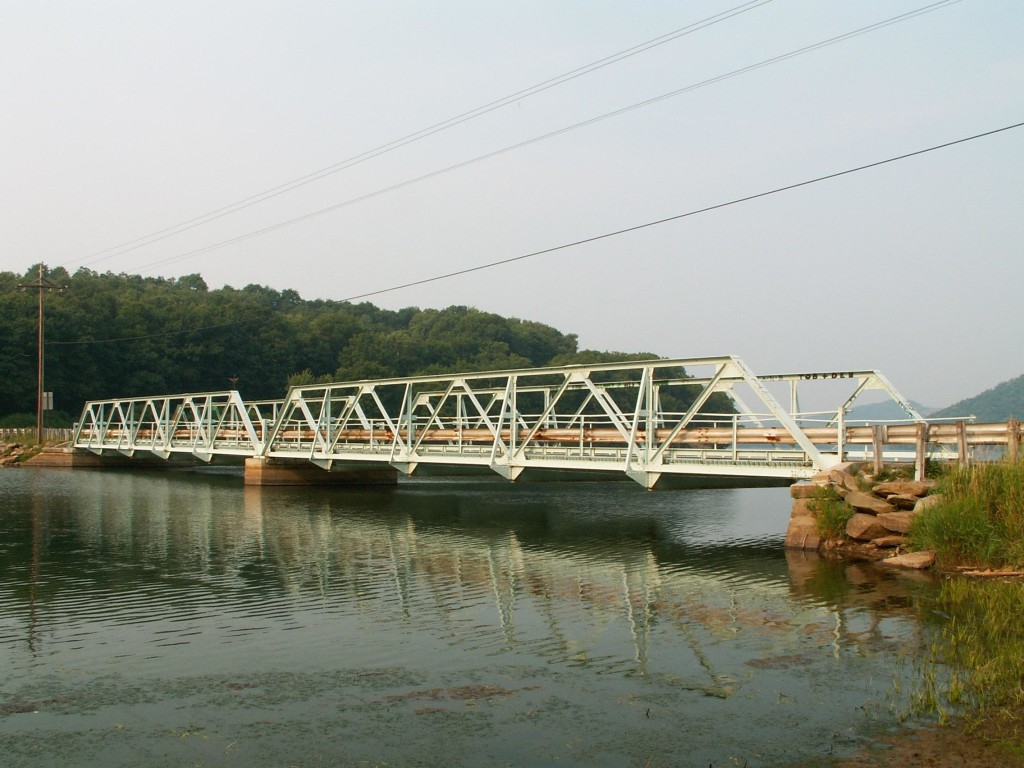
Kiefel Bridge, taken by Nathaniel Holth. Courtesy of historicbridges.com. 2013. Used by permission of Nathaniel Holth.
Although you might need to duck your head as you glide along Quemahoning Creek underneath this 1913 Warren Pony Truss bridge in Jenner Township, Somerset County, the view of the rolling hills surrounding the Quemahoning Reservoir and recreation area more than reward you for your efforts! This bridge features two spans, which means that there are two Warren Truss sections used in combination to achieve the length needed to cross Quemahoning Creek.
Watsontown River Bridge, Union County and Northumberland County
The 1927 Watsontown River Bridge is a beautiful example of an open spandrel arch concrete bridge crossing the Susquehanna River, and it was listed on National Register in 1988. Connecting Watsontown in Northumberland County and White Deer Township in Union County at a length of over one thousand feet, this breath-taking concrete bridge features nine arches crossing the Susquehanna, each of which is further detailed by the inclusion of eight smaller arches within the open spandrel spaces. Designed by J.B. Long and built by George W. Rockwell, the Watsontown River Bridge is an excellent example of what could be accomplished in concrete in the early twentieth century.
Pennsylvania is home to upwards of 25,000 bridges, many of which are historically significant – or, at least, are pleasing to behold. From the nation’s earliest covered and metal bridges, to grand decorative concrete arches, exploring Pennsylvania’s waterways is a matchless way to glimpse pieces of our important transportation history while simultaneously embracing the wild scenery that makes Pennsylvania special! As you plan your upcoming excursions, just remember that the examples listed above are simply a tiny sliver of what you may have the privilege to discover on your journey!
Elizabeth Shultz is a graduate thesis candidate in Historic Preservation at Tulane University’s School of Architecture in New Orleans, Louisiana, as well as being a current PennDOT Historic Preservation intern. Elizabeth previously interned at the PA SHPO in the spring of 2014, and her most recent internship was at the New Orleans Historic District Landmarks Commission. Elizabeth hails originally from Lock Haven, Pennsylvania.
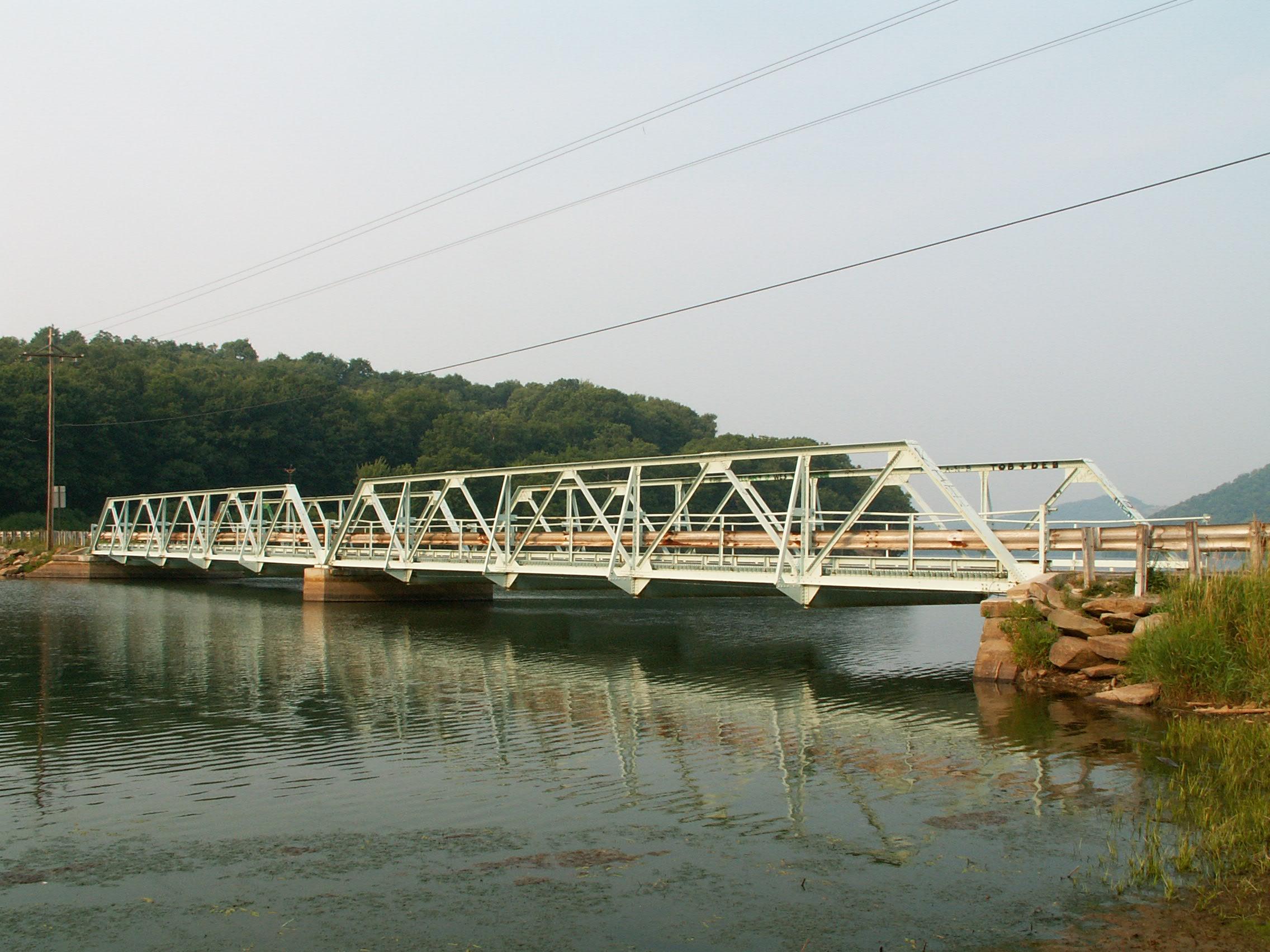
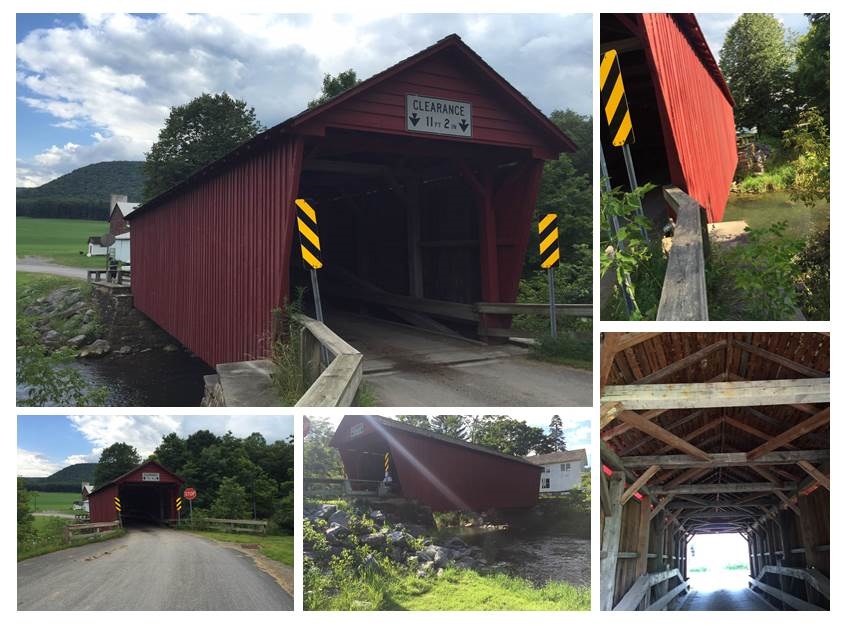
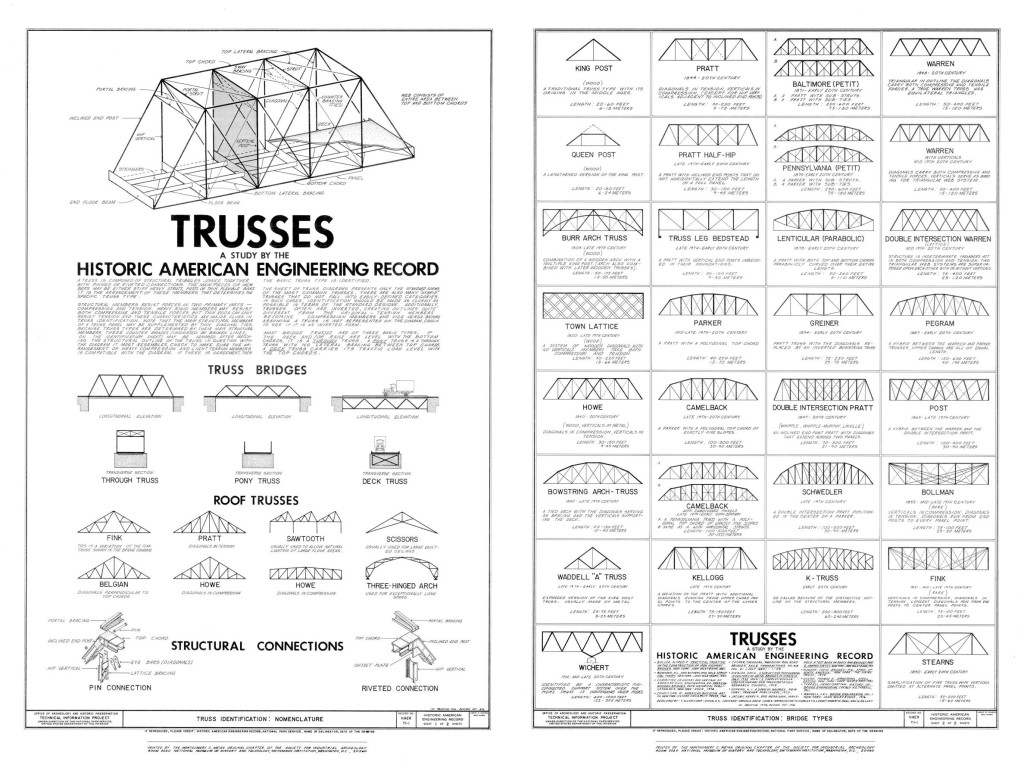
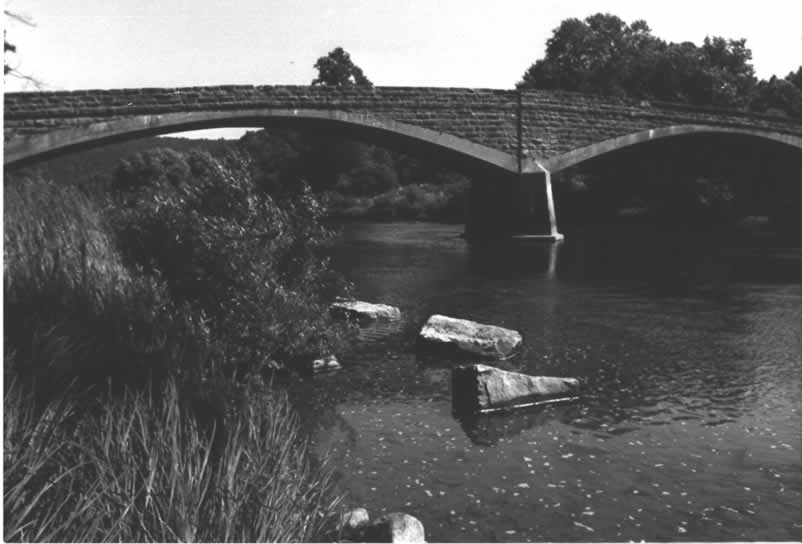
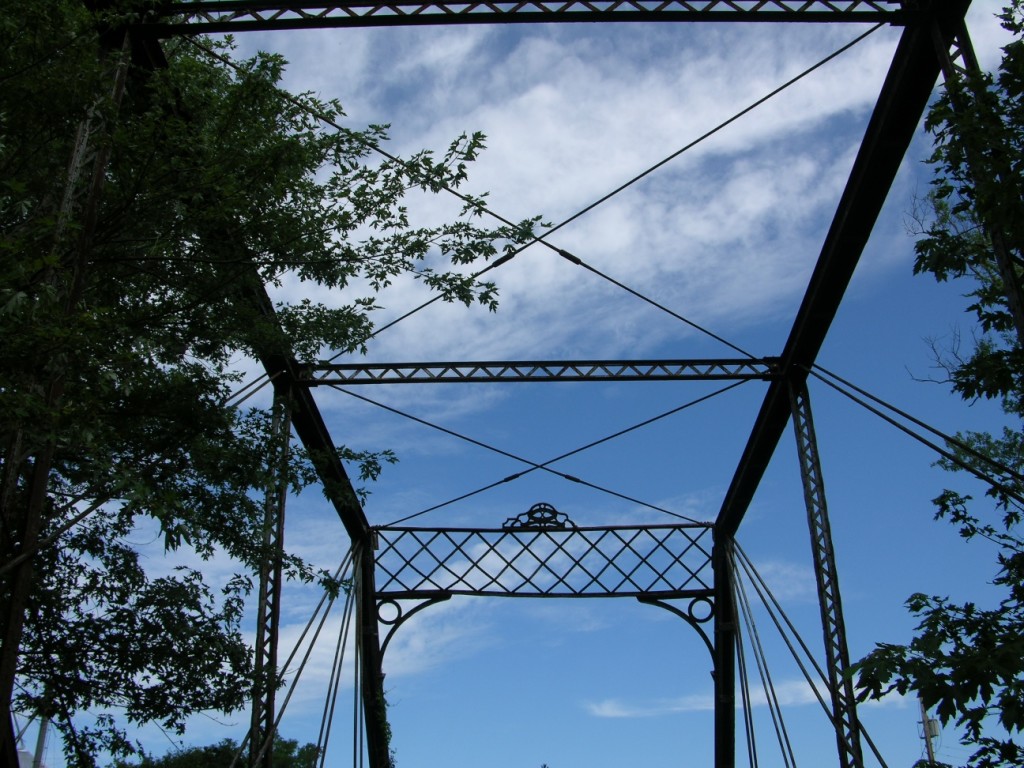

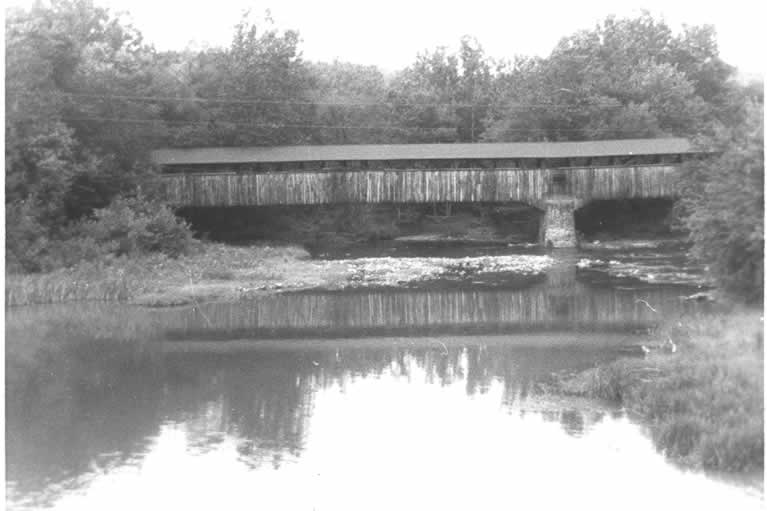
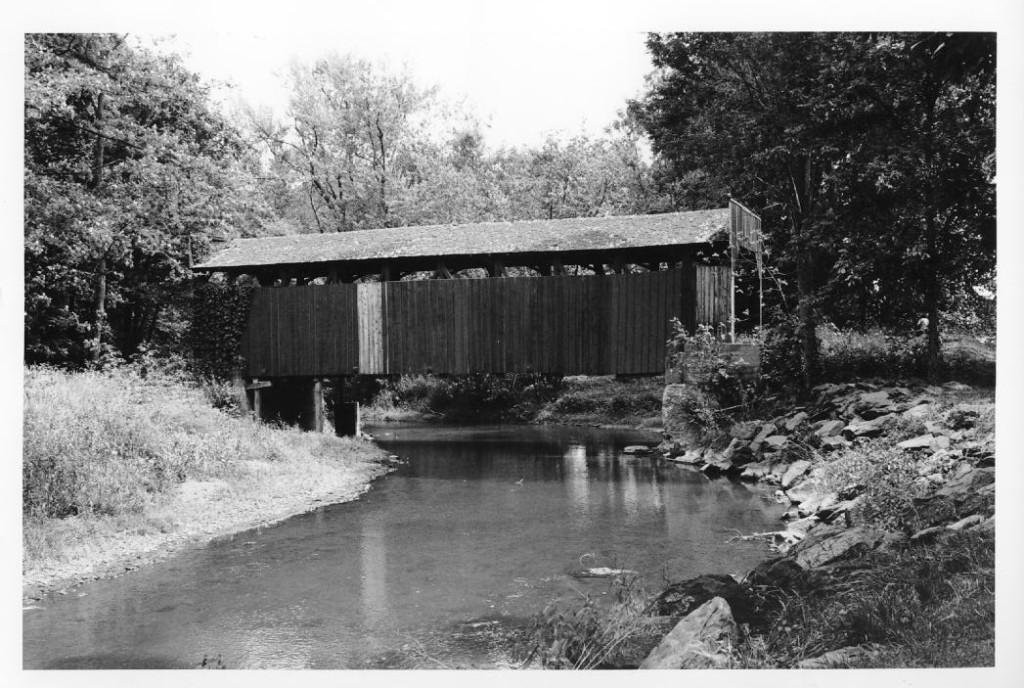
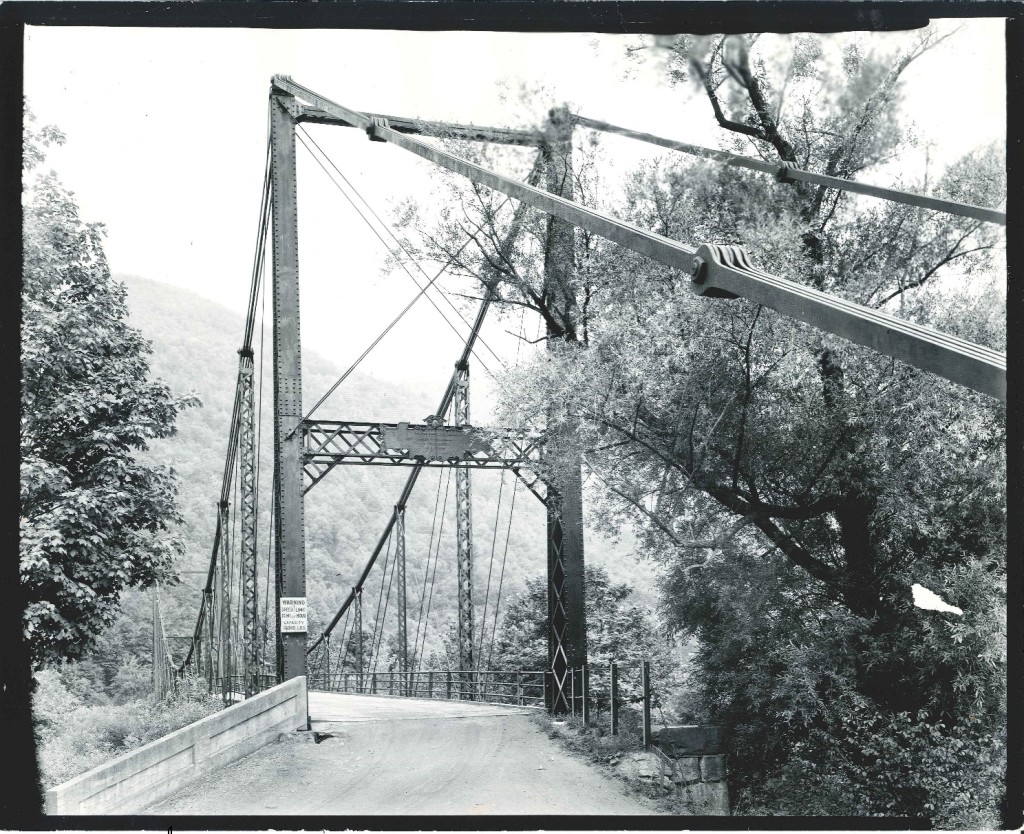
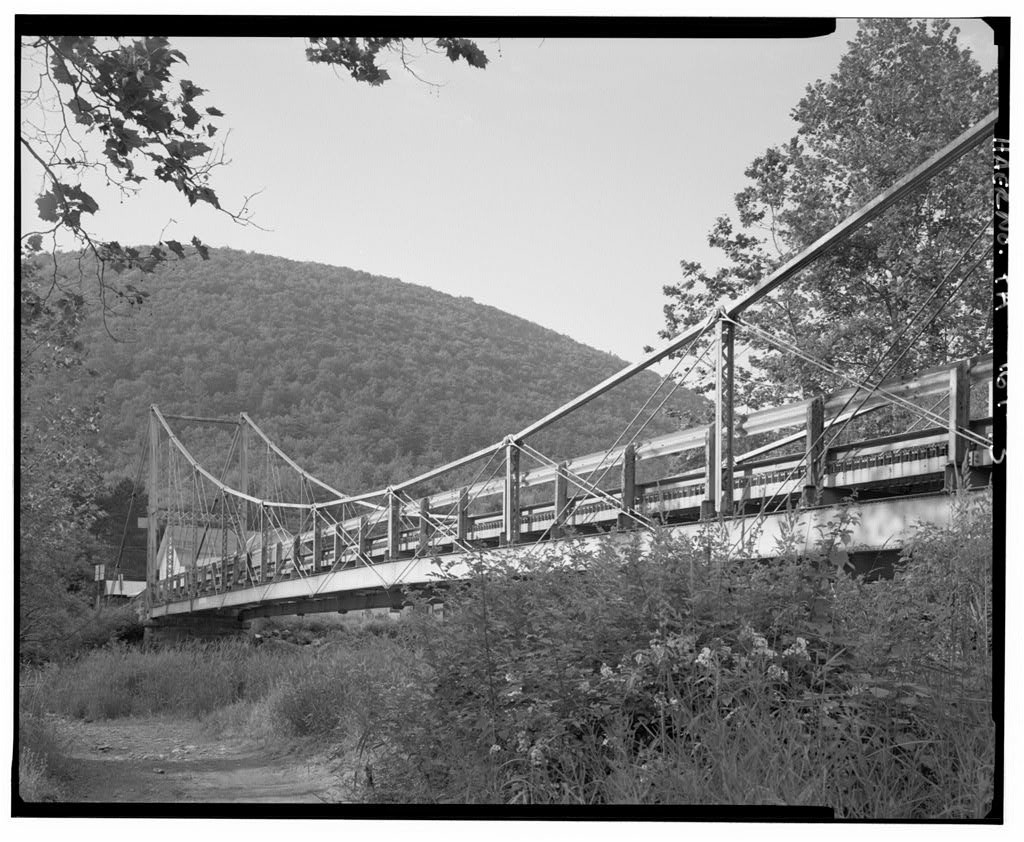
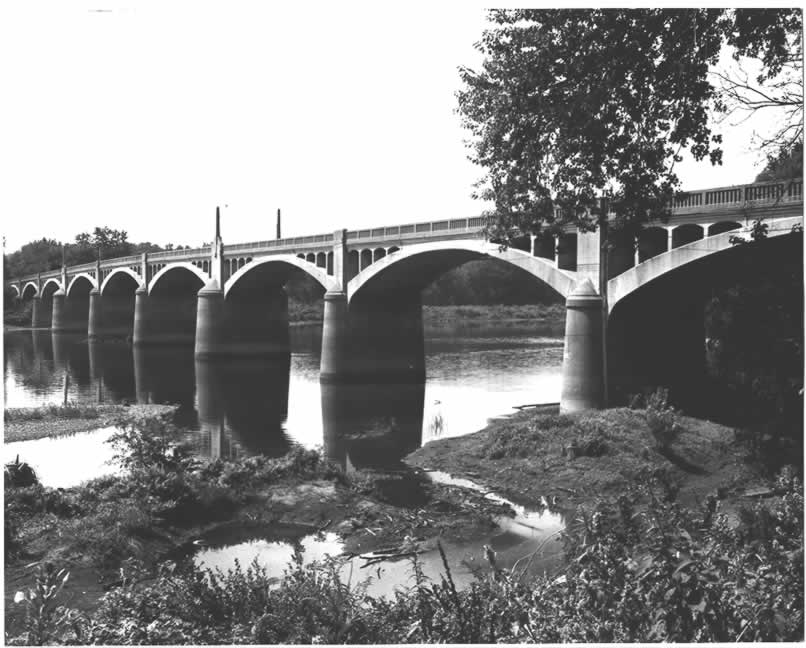
Leave a Reply